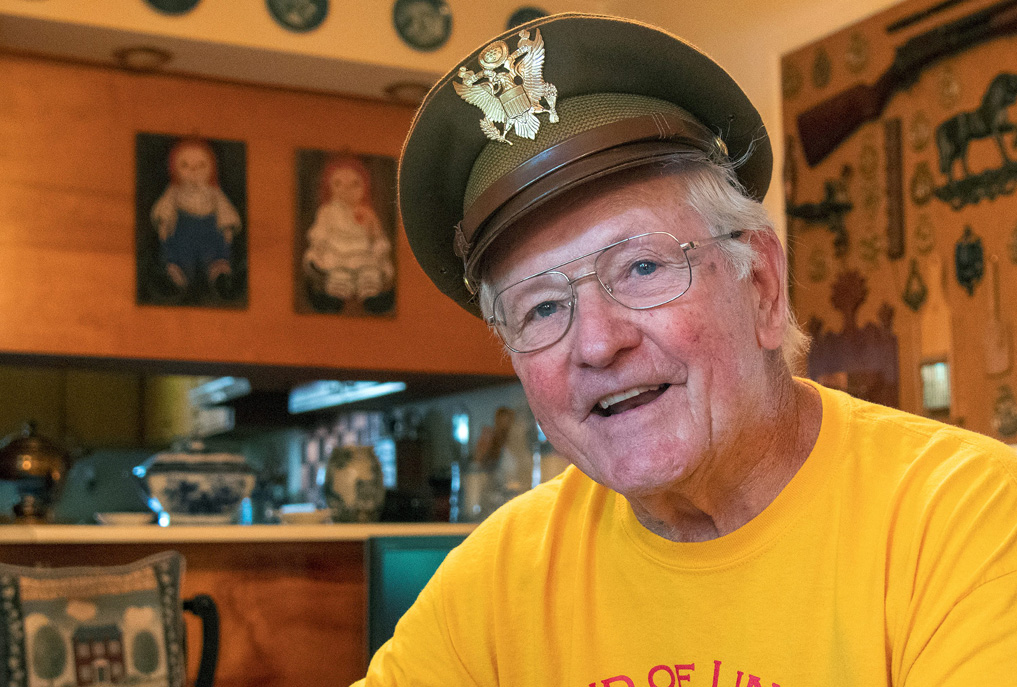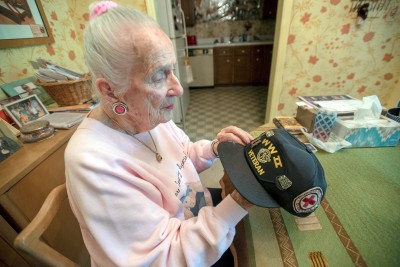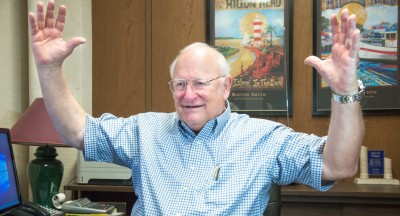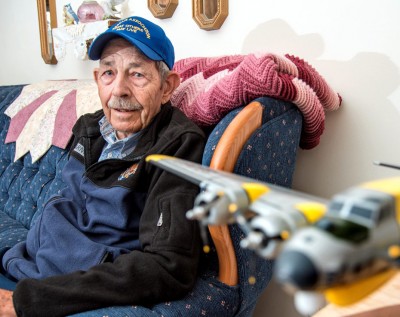Fredrick Holhubner
By Paul Wood

Photo By Stephen Haas/The News-Gazette
URBANA — To make sure his Army students knew how to put their protective gear on properly, Lt. Fredrick Holhubner had a secret weapon.
After tear gas, it was another gas released — if their masks weren’t on correctly, they’d throw up right in them.
“It made them learn really quickly,” he said.
It was Holhubner’s mission to teach soldiers about chemical, biological and nuclear warfare when he was stationed in the U.S. and Germany during the Cold War.
Now 88, he still is active in the Exchange Club and passes out American flags in the Freedom Celebration parade.
His early years were challenging. He grew up on a farm in Pulaski County in southern Illinois with family members from Germany and Austria. (A cuckoo clock sings out just as he was saying that.)
“There was only one Lutheran church in the county,” he said. His family helped start it.
He lived through the Depression in a house lit by kerosene lamps.
In 1947, Holhubner went off to college at Southern Illinois University in Carbondale to study agriculture while working full time at Prairie Farms Creamery.
After three years, he transferred to the University of Illinois, improving on his chemistry skills, and again working at the creamery.
He got engaged to Dolores (now passed) in June 1951, and by August was training with the 101st Airborne.
Holhubner scored so high on his tests there that he was sent to Officer Candidate School at Fort Riley, Kan.
A colonel told him, “If you screw up, we have a plane to take you to Korea,” he remembered.
In Alabama, his training included smoke generators and smoke grenades. Smoke cover could also be fired from mortars.
Because of his chemistry knowledge, Holhubner started training troops how to stay alive if war broke out with the Soviet Union.
He spent much of his active duty time in Germany.
“We trained troops in how to deal with chemical, biological and radiological warfare,” he said. “We were especially concerned about nerve gas because it had been used and proved effective. If you were exposed, you died in about three minutes.”
The G-agents were so named because German scientists first synthesized them before World War II — the first nerve gasses to be made.
The only antidote: a shot of atropine right into the muscle in their leg. (In training, it was a harmless solution).
Many of the trainees couldn’t deal with pushing a needle deep into muscle.
A veteran officer liked to make them squeamish by plunging a needle in his leg, “and letting it bounce around as he walked,” Holhubner said.
Better than a cure was protection. The lieutenant was strict about suits and masks, putting them through an unforgettable experience of taking measures against tear gas and then “puking gas,” adamsite.
A bit of Urbana trivia: Adamsite was developed by the Germans and independently by Professor Roger Adams (for whom it is named) at the UI in 1918.
As for radiation poisoning, soldiers were taught how to use three types of protection from alpha, beta and especially gamma rays, he said.
Holhubner left active service in 1954.
“I was one of the fortunate ones,” he said. “I had friends killed or injured in Korea. I was never in direct conflict.”
After his service, he earned graduate degrees and had a long and successful career in Cooperative Extension.
That eventually brought him to Urbana, from where he traveled extensively.
At the UI, he was a field administrator, then the go-to guy to solve problems, which often took him to Washington.
Later, he took cruises with his wife.
Even in Extension, he served as a reserve officer, teaching chemical, biological and radiological protection at a time when schoolchildren were taught to “duck and cover” if they faced a nuclear threat.
Do you know a veteran who could share a story about military service? Contact Paul Wood at pwood@news-gazette.com.
Read more stories from local veterans:
 Jill Knappenberger
CHAMPAIGN — In 100 years that have shown extreme courage in World War II and a lifetime of commitment to her church and …
Jill Knappenberger
CHAMPAIGN — In 100 years that have shown extreme courage in World War II and a lifetime of commitment to her church and …
 John Phipps
CHAMPAIGN — During the Berlin Wall crisis in 1961, John Phipps was working as the Air Force base provost marshal, in cha …
John Phipps
CHAMPAIGN — During the Berlin Wall crisis in 1961, John Phipps was working as the Air Force base provost marshal, in cha …
 Ted Barnhart
CHAMPAIGN — Flying rescue missions during the Korean War, Ted Barnhart was the radar operator as his B-17 skimmed over p …
Ted Barnhart
CHAMPAIGN — Flying rescue missions during the Korean War, Ted Barnhart was the radar operator as his B-17 skimmed over p …